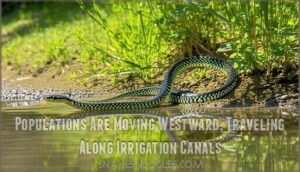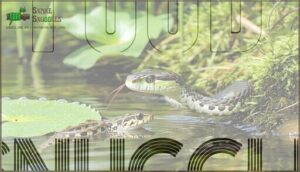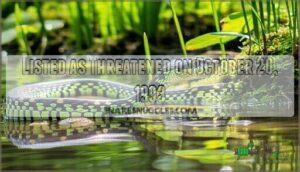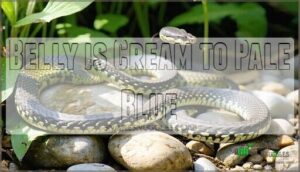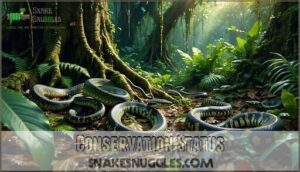This site is supported by our readers. We may earn a commission, at no cost to you, if you purchase through links.
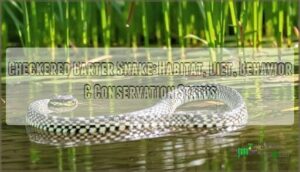
These semi-aquatic hunters make wetlands their home base, cruising through irrigation canals like watery highways between hunting grounds.
As daytime predators, they hunt fish, tadpoles, and earthworms, stretching up to 63 inches long with cream-colored bellies that match their water-loving lifestyle.
While these serpents are ecological champions in their wetland habitats, they’re facing real conservation challenges from habitat loss and climate change—making every sighting a treasure worth protecting.
Table Of Contents
- Key Takeaways
- Habitat
- Food
- Behavior
- Physical Characteristics
- Conservation Status
- Frequently Asked Questions (FAQs)
- What is the average length of a checkered garter snake?
- Is the checkered garter snake venomous?
- What do checkered garter snakes eat?
- How do checkered garter snakes reproduce?
- What is the conservation status of the checkered garter snake?
- How long do checkered garter snakes live?
- What predators hunt checkered garter snakes?
- When do checkered garter snakes mate and reproduce?
- Are checkered garter snakes venomous or dangerous?
- How can you identify checkered garter snakes?
- Conclusion
Key Takeaways
- You’ll recognize them instantly by their distinctive black-and-white checkerboard pattern and cream-colored bellies—they’re semi-aquatic hunters that can grow up to 63 inches long.
- You’ll find them expanding westward, using irrigation canals as highways between wetland territories, where they hunt fish, tadpoles, and earthworms during daylight hours.
- You’re looking at a threatened species, listed since 1993, facing serious conservation challenges from habitat loss, invasive plants, and climate change impacts like drought and flooding.
- You can help protect them by supporting wetland preservation efforts and reporting sightings, since these snakes serve as key indicators of ecosystem health in their changing environments.
Habitat
You’ll find checkered garter snakes thriving in wetlands where tall grasses and dense vegetation create perfect hunting grounds and escape routes from predators.
These adaptable reptiles are expanding their range westward, cleverly using irrigation canals as highways to reach new territories and water sources.
Requirements: Tall Vegetation for Hunting and Escape From Predators
If you’re wondering why checkered garter snakes need thick vegetation, it’s all about survival. These snakes depend on dense plant cover for both hunting success and predator avoidance—think of it as their natural security blanket.
The checkered garter snake habitat requires specific vegetation density to function properly. Tall grasses and wetland plants create the perfect hunting grounds where these serpents can ambush prey while staying hidden from larger predators. This escape cover isn’t just convenient—it’s essential for their survival.
Vegetation density shapes everything about how these snakes live:
- Hunting Success: Dense plants provide camouflage for stalking fish, frogs, and earthworms near water’s edge
- Predator Avoidance: Thick cover offers quick escape routes from birds, mammals, and larger snakes
- Habitat Quality: Vegetation creates the microhabitats these snakes need for thermoregulation and shelter
Without adequate plant cover, snake behavior changes dramatically—they become more vulnerable and less successful hunters.
Populations Are Moving Westward, Traveling Along Irrigation Canals
You’ll see something striking happening across the Southwest—checkered garter snakes are expanding their territory using human-built irrigation canals as highways. This westward population movement represents a conservation success story.
Canal expansion has created habitat connectivity that wouldn’t naturally exist, allowing genetic diversity to flourish as isolated populations connect. Up to 88% of these snakes now live within 50 meters of irrigation ditches during active months. These artificial waterways serve as lifelines, helping threatened populations find new territory and mates.
Canal expansion creates habitat highways for checkered garter snakes, with 88% now living near irrigation ditches that connect isolated populations
These snakes primarily consume semi-aquatic prey, such as fish and tadpoles. While conservation strategies usually focus on preserving natural habitat, this distribution shift shows how thoughtful infrastructure can benefit wildlife too.
Food
Understanding their perfect wetland habitat means knowing what fuels these striking reptiles. Checkered garter snake diet centers on aquatic and semi-aquatic creatures, making prey availability around water sources critical for survival. Dietary habits shift dramatically as snakes mature—juvenile diet consists primarily of earthworms (60%), while adults pivot to tadpoles (62%). Their smooth scales aid in swift movement through dense grass.
Their hunting strategies rely on chemical detection through tongue-flicking and ambush tactics near stream edges. Dietary adaptations allow them to exploit seasonal prey booms during amphibian breeding cycles. You’ll find them consuming:
- Small frogs and toads during spring breeding seasons
- Fish and tadpoles in permanent water bodies
- Earthworms and aquatic invertebrates year-round
- Small rodents and lizards when available
- Amphibian eggs during peak spawning periods
Unlike venomous species, checkered garter snakes lack venom toxicity, relying instead on quick strikes and swallowing prey whole. This snake diet flexibility helps populations survive in changing environments, though declining wetlands threaten their food web connections.
Behavior
After a good meal, checkered garter snakes get pretty interesting to watch. These daytime lovers stick to predictable routines that reveal a lot about how they live. You’ll catch them out during daylight hours, but they’re anything but boring. They hunt by ambushing prey near water with incredible speed. What sets them apart from other garter snakes? They’re also active at night when it gets too hot during the day.
When males bump into each other, things get heated fast. They’ll push head-to-head until one backs down, sometimes throwing in dramatic hissing for good measure.
Come spring breeding season, their mating game is all about scent. Males release powerful pheromones to win over females in what becomes a pretty competitive show.
All these quirks make checkered garter snakes stand out from other reptiles in some pretty cool ways.
Physical Characteristics
You’ll easily spot these impressive snakes by their striking checkered pattern and cream to pale blue bellies, which make them stand out among North America’s native reptiles.
At lengths reaching up to 63.7 inches, they’re among the larger garter snake species and play an important role in wetland ecosystems as both predators and prey.
Length: Up to 63.7 Inches (162 Centimeters)
You’ll find checkered garter snakes reaching impressive lengths up to 63.7 inches, though most adults average around 28 inches. Greatest size varies considerably across populations, with sexual dimorphism evident as females usually grow larger than males.
Growth rate depends on food availability and habitat quality.
Their scalation count and physical characteristics make identification straightforward—look for the distinctive checkered pattern running along their bodies.
Size variation reflects regional differences, with southern populations often achieving greater lengths than their northern cousins.
Listed as Threatened on October 20, 1993
You’ll find that the checkered garter snake faces serious conservation challenges after its threatened species classification. The listing justification stems from significant population decline caused by habitat fragmentation across its range.
Scientists are tackling this challenge through four main approaches:
- Habitat protection through wetland preservation
- Recovery strategies involving population monitoring
- Targeted research on conservation status and threats
- Enhanced protection measures to prevent further decline
These threatened species protections help scientists track population trends and implement recovery strategies before it’s too late.
Belly is Cream to Pale Blue
You’ll notice the checkered garter snake’s belly displays striking cream to pale blue coloration, creating an excellent camouflage advantage against predators. This belly coloration shows fascinating regional differences—southern specimens often feature more pronounced bluish tones.
The genetic variation in physical appearance helps with predator avoidance, making checkered garter identification easier when you spot these distinctive snake characteristics during field observations.
Conservation Status
You’ll find checkered garter snakes face serious conservation challenges, especially as climate change and habitat loss threaten their wetland homes.
These resilient reptiles depend on permanent water sources, making them particularly vulnerable when droughts strike or invasive plants crowd out their hunting grounds.
Protected Throughout Georgia
Georgia doesn’t provide special protections for checkered garter snakes because they’re not in immediate danger of extinction in the state.
These snakes maintain stable populations, so they don’t qualify for the same protective status as threatened species.
However, Georgia’s broad Conservation laws still provide habitat preservation through general non-venomous snake protections. This Conservation Status means you can’t legally harm or capture them without permits.
Population Monitoring efforts continue through state conservation programs, guaranteeing Legal Ramifications exist for violations. These Conservation Efforts help maintain stable populations while broader Habitat conservation initiatives statewide.
Invasive Aquatic Plants and Removal Techniques
Over 6,500 invasive species now threaten checkered garter snake wetland habitats across the United States. Plant competition from water hyacinth and Eurasian watermilfoil creates dense mats that disrupt hunting grounds you’d normally find these snakes using.
Conservation efforts employ multiple removal techniques: herbicide use targets specific invasive plants, while biological control introduces natural predators. Mechanical harvesting physically removes biomass, though disposal matters since fragments regrow quickly.
Prevention methods focus on early detection and rapid response. Habitat restoration following removal helps native vegetation recover, supporting the aquatic ecosystems these threatened snakes desperately need.
Impacts of Climate Change, Including Flooding and Drought
Climate change creates a perfect storm for checkered garter snakes through altered hydrology and extreme weather events. These snakes face prey scarcity as droughts eliminate amphibian breeding pools, while flooding destroys critical wetland habitats.
Range shifts northward are already documented, but habitat fragmentation limits their movement options. Genetic diversity suffers when isolated populations can’t reconnect.
Conservation efforts now focus on protecting riparian corridors and implementing climate-adaptive conservation strategies to help these threatened reptiles survive our changing world.
Drought Threatens Due to Dependence on Permanent Wetlands
Without permanent wetlands, you’ll find checkered garter snakes struggling against drought’s relentless advance. Water scarcity creates habitat degradation, fragmenting their world into isolated patches.
Climate change intensifies these challenges, forcing conservation efforts to focus on wetland restoration. During severe droughts like California’s 2012-2015 crisis, populations plummeted as their aquatic lifelines disappeared, leaving these notable reptiles fighting for survival.
Frequently Asked Questions (FAQs)
What is the average length of a checkered garter snake?
You’ll find that checkered garter snakes can reach up to 7 inches in length, though most adults you’ll encounter usually range between 24-48 inches long.
Is the checkered garter snake venomous?
Checkered garter snakes are completely non-venomous and pose no threat to humans.
They’re harmless constrictors that rely on their quick reflexes and camouflage rather than venom to survive in wetland environments.
What do checkered garter snakes eat?
You’ll find these snakes munching on fish, frogs, toads, earthworms, and small rodents. They’re smart hunters who stick near water sources where their favorite aquatic prey hangs out.
How do checkered garter snakes reproduce?
In spring, checkered garter snakes gather for mating season where males compete for females in what can only be described as nature’s version of a wrestling match.
They’re ovoviviparous, meaning females carry developing eggs internally and give birth to 6-35 live young between July and September.
What is the conservation status of the checkered garter snake?
You’ll find checkered garter snakes listed as threatened in Kansas, where they’re protected by state conservation laws. Their populations face challenges from habitat loss and fragmentation.
How long do checkered garter snakes live?
You’ll find checkered garter snakes living about seven years in captivity, though wild lifespans aren’t well-documented.
These resilient reptiles face threats from habitat loss that can shorten their natural lifespan considerably.
What predators hunt checkered garter snakes?
Nature’s food web puts these snakes in danger’s path constantly.
You’ll find large birds like hawks swooping down, mammals such as raccoons hunting near water, and other snakes viewing them as meals.
When do checkered garter snakes mate and reproduce?
You’ll spot checkered garter snakes mating in spring after they emerge from winter hideouts. Females give birth to 6-35 live young during summer months, usually between July and September.
Are checkered garter snakes venomous or dangerous?
Picture a housecat with claws made of tissue paper—that’s how harmless checkered garter snakes are to humans. Sure, they have mild neurotoxic venom, but it’s so weak it can’t hurt you at all.
They might give you a defensive bite if you corner them, but there’s absolutely no danger.
How can you identify checkered garter snakes?
You’ll recognize checkered garter snakes by their distinctive black-and-white checkered pattern, cream to pale blue belly, and yellow crescent-shaped marks behind their heads. They’re commonly found near water sources.
Conclusion
Checkered garter snakes are quietly expanding their range westward, following irrigation canals and ditches like highways to new territory.
This species profile checkered garter snake reveals a resilient wetland dweller facing mounting conservation challenges. You can help by supporting habitat protection efforts and reporting sightings to local wildlife agencies.
These semi-aquatic hunters serve as key indicators of ecosystem health, making their conservation essential for maintaining balanced wetland communities across their shifting range.


